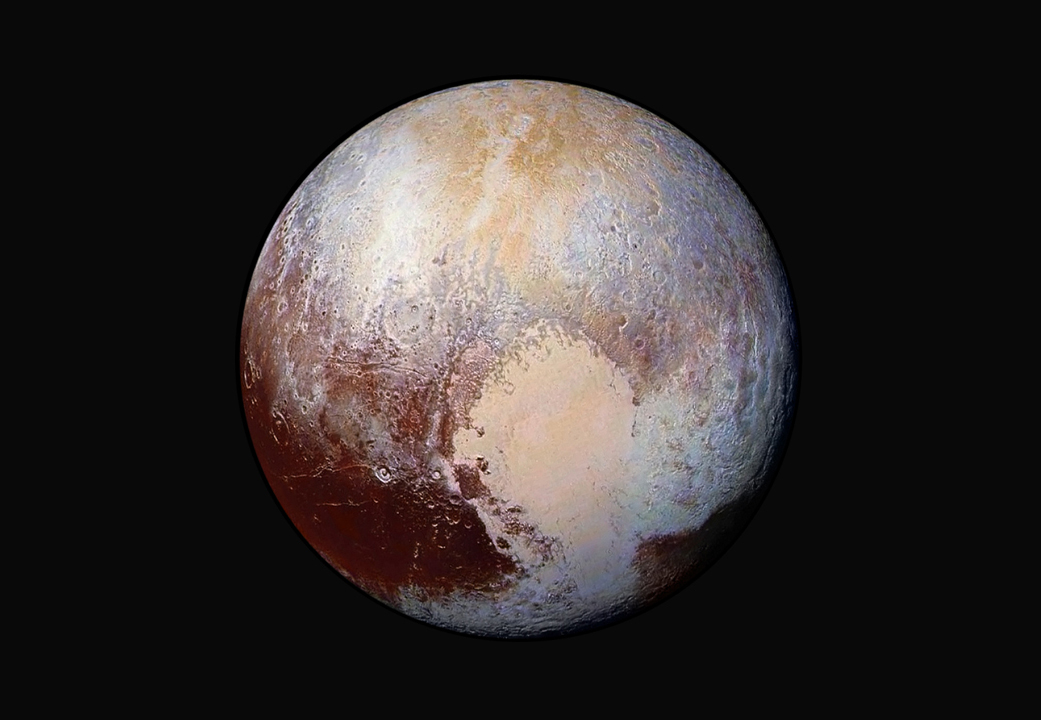Here's What Pluto's Frozen 'Heart' Looks Like in False Color

The mysterious face of Pluto is beginning to yield some of its secrets in this stunning false-color image from NASA's New Horizons spacecraft, which scientists can use to detect subtle differences in the dwarf planet's surface, including its icy "heart."
The new image of Pluto, released on Thursday (July 23), clearly shows the now familiar heart-shaped region nicknamed Tombaugh Regio. The photo is actually a combination of observations from the main camera on New Horizons (called LORRI) and the probe's visible/infrared imager (known as Ralph) which provided data for the colors in the view. The enhanced colors allow scientists to identify differences in the composition and texture of Pluto's surface, according to a NASA image description.
"The 'heart of the heart,' Sputnik Planum, is suggestive of a source region of ices,'" NASA officials wrote in the image description. Sputnik Planum is the vast plains region inside Pluto's heart-shaped feature. "The two bluish-white 'lobes' that extend to the southwest and northeast of the 'heart' may represent exotic ices being transported away from Sputnik Planum." [Take a video tour of Pluto's 'heart' in false color]
The New Horizons spacecraft captured this view in the days leading up to its historic July 14 flyby of Pluto. At the time, New Horizons was about 280,000 miles (450,000 kilometers) from the dwarf planet. Four images from the probe's LORRI camera (short for Longe Range Reconnaissance Imager) were combined with the color data from the Ralph instrument to create this view.
Pluto's heart-shaped region was named Tombaugh Region in honor of the late astronomer Clyde Tombaugh, who discovered Pluto in 1930 while working at the Lowell Observatory in Flagstaff, Arizona.
NASA will unveil more new photos of Pluto from New Horizons later today at 2 p.m. EDT (1800 GMT) during a press conference at its headquarters in Washington, D.C. You can watch the Pluto webcast live on Space.com, courtesy of NASA TV.
Breaking space news, the latest updates on rocket launches, skywatching events and more!
Email Tariq Malik at tmalik@space.com or follow him @tariqjmalik and Google+. Follow us @Spacedotcom, Facebook and Google+. Original article on Space.com.

Tariq is the award-winning Editor-in-Chief of Space.com and joined the team in 2001. He covers human spaceflight, as well as skywatching and entertainment. He became Space.com's Editor-in-Chief in 2019. Before joining Space.com, Tariq was a staff reporter for The Los Angeles Times covering education and city beats in La Habra, Fullerton and Huntington Beach. He's a recipient of the 2022 Harry Kolcum Award for excellence in space reporting and the 2025 Space Pioneer Award from the National Space Society. He is an Eagle Scout and Space Camp alum with journalism degrees from the USC and NYU. You can find Tariq at Space.com and as the co-host to the This Week In Space podcast on the TWiT network. To see his latest project, you can follow Tariq on Twitter @tariqjmalik.
